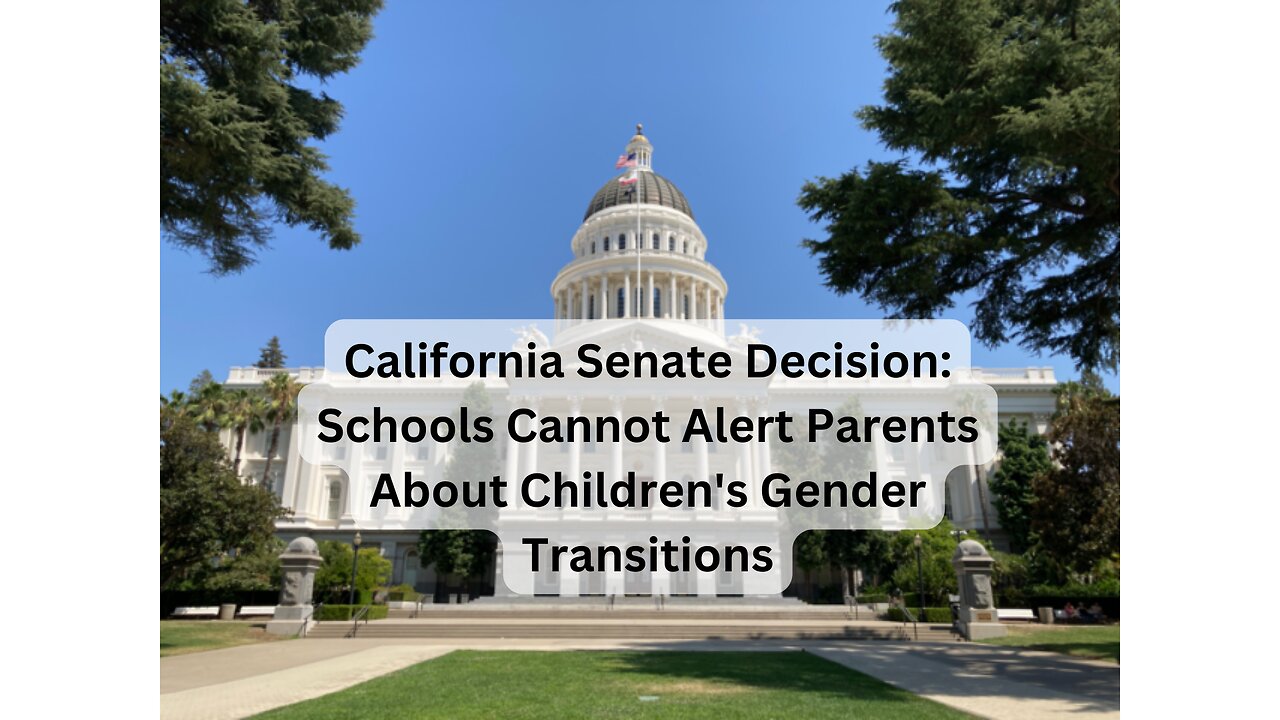Premium Only Content

Shocking Move: California Senate Bans Schools from Informing Parents on Gender Transitions
The California Senate has passed Assembly Bill 1955, a measure preventing school districts from notifying parents about their children's "social" gender transition at school without the child's consent. The bill, approved by a 29-8 vote, will now return to the Assembly for final approval of amendments. This legislation responds to policies in some California school districts that require notifying parents if a student undergoes a "social" gender transition, where the student publicly identifies as a different gender with affirmation from teachers and peers.
AB 1955 aligns with guidance from California’s Department of Education, which mandates that schools must consult with transgender students to decide who will be informed of their transgender status, including their families. Proponents, like Democratic Senator Susan Eggman, assert that the bill fosters a supportive environment crucial for students' self-discovery. Eggman emphasized the importance of allowing students to explore their identities without undue interference, stating that schools should not act as "the gender police" but rather ensure safety and affirmation for all students.
Opponents of the bill argue that parents have a right to be informed about significant aspects of their children's development, including issues related to gender identity. They warn that the bill represents excessive state intrusion into family affairs and sets a concerning precedent. Recent incidents, such as Montana parents losing custody of their child for opposing her gender transition, underscore these fears. Republican Assemblyman Jim Patterson criticized the bill for creating a barrier between children and parents, insisting that the state should not assume control over parental roles.
Detractors label AB 1955 as "unconstitutional, morally corrupt," and "an embarrassment for our state," reflecting deep divisions over the appropriate role of schools and parents in addressing students' gender identities.
-
 1:33
1:33
Conspiracy Chronicle
8 months agoTrump Declares War on Big Tech Censorship with Bold FCC Pick
1451 -
 12:15
12:15
Nikko Ortiz
13 hours agoMonday Gun Fails
2.44K4 -
 2:10:32
2:10:32
Side Scrollers Podcast
16 hours agoStreamer Nearly Beats A Man to Death on Stream + Twitch Viewership PLUMMETS + More | Side Scrollers
2.57K4 -
 13:09
13:09
Forrest Galante
1 day agoWildlife Expert Reacts To Deadly Australian Animal TikToks
70.6K13 -
 23:47
23:47
GritsGG
2 days agoThe Forgotten Best Sniper Support AR!
23.1K4 -
 10:18
10:18
The Pascal Show
15 hours ago'I WILL NOT GIVE UP ON MY BABY!' Emmanuel Haro's Mom Breaks Silence From Jail?!
32 -
 LIVE
LIVE
Lofi Girl
2 years agoSynthwave Radio 🌌 - beats to chill/game to
161 watching -
 2:33:04
2:33:04
Badlands Media
12 hours agoBaseless Conspiracies Ep. 147: Pole Shifts, Plasma Skies, and the Truth About Cataclysms
145K17 -
 4:33:42
4:33:42
Drew Hernandez
8 hours agoISRAEL BOMBS GAZA HOSPITAL ON LIVE TV KILLING AT LEAST 20 INCLUDING JOURNALISTS & CIVILIANS
17K32 -
 2:55:23
2:55:23
TimcastIRL
7 hours agoTrump Orders Specialized National Guard Units To Combat Crime In Cities, Dems Furious | Timcast IRL
196K141